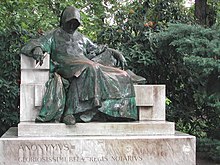Vajdahunyad Castle: Difference between revisions
m r2.7.1) (robot Adding: eo:Historiisma fortikaĵo Vajdahunyad |
+ru |
||
| Line 39: | Line 39: | ||
[[nl:Vajdahunyadburcht]] |
[[nl:Vajdahunyadburcht]] |
||
[[pl:Zamek Vajdahunyad]] |
[[pl:Zamek Vajdahunyad]] |
||
[[ru:Замок Вайдахуняд]] |
|||
Revision as of 09:50, 20 July 2011




- For the castle in present-day Hunedoara, Romania, see Hunyad Castle.
Vajdahunyad Castle, or Vajdahunyad-vár, is a castle in City Park, Budapest, Hungary, that was built between 1896 and 1908, designed by Ignác Alpár. It is a copy in part of a castle in Transylvania, Romania, that is also called Vajdahunyad, though it is also a display of different architectural styles: Romanic, Gothic, Renaissance and Baroque.
Originally it was made from cardboard and wood for the millennial exhibition in 1896 but it became so popular that it was rebuilt from stone and brick.
Today it houses the Agricultural Museum.
The statue of Anonymus, also displayed in the Castle court, was a chronicler in the 12th century (probably of King Béla III). He wrote the first history books on the ancient Hungarians, mostly based on legends. Superstition says that by touching his pen you will receive good luck.
It also contains a statue of Bela Lugosi, dedicating his work.
External links
47°30′55″N 19°4′55″E / 47.51528°N 19.08194°E
